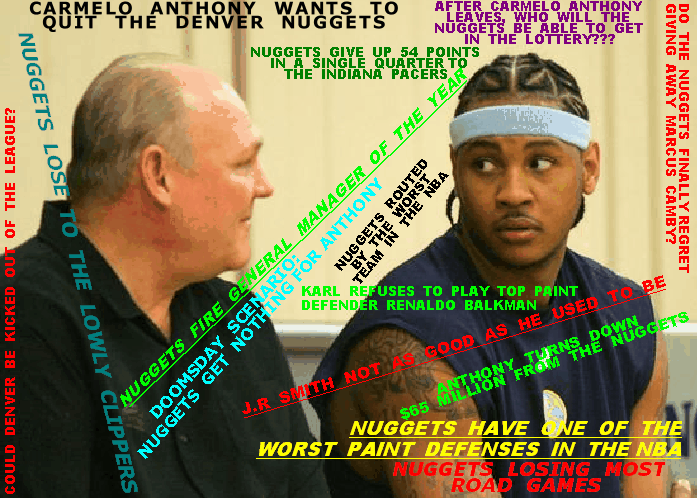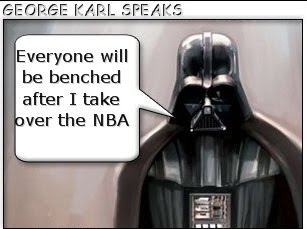Note: This is generally a once a year, end of season Report. For many teams and players, more recent ratings are often available.
NBA REAL PLAYER RATINGS
2009-10 REGULAR SEASON
POSITION AND TEAM CODES
In the Real Player and related ratings shown for the League, two codes follow each players' name (and before his rating). The first code tells you the players' team and the second one tells you his position.
TEAM CODES
ATLA Atlanta Hawks
BOST Boston Celtics
CHAR Charlotte Bobcats
CHIC Chicago Bulls
CLEV Cleveland Cavaliers
DALL Dallas Mavericks
DENV Denver Nuggets
DETR Detroit Pistons
GOLS Golden State Warriors
HOUS Houston Rockets
INDI Indiana Pacers
LACL Los Angeles Clippers
LALK Los Angeles Lakers
MEMP Memphis Grizzlies
MIAM Miami Heat
MILW Milwaukee Bucks
MINN Minnesota Timberwolves
NJRS New Jersey Nets
NORL New Orleans Hornets
NWYR New York Knicks
OKLA Oklahoma Thunder
ORLA Orlando Magic
PHIL Philadelphia 76'ers
PHNX Phoenix Suns
PORT Portland Trailblazers
SACR Sacramento Kings
SANA San Antonio Spurs
TORO Toronto Raptors
UTAH Utah Jazz
WASH Washington Wizards
POSITION CODES
PG Point Guard
SG Shooting Guard
SF Small Forward
PF Power Forward
C Center
SCALE FOR REGULAR SEASON REAL PLAYER RATINGS
Perfect for all Practical Purposes / Major Historic Super Star 1.100 and more
Historic Super Star 1.000 1.099
Super Star 0.900 0.999
A Star Player / A well above normal starter 0.820 0.899
Very Good Player / A solid starter 0.760 0.819
Major Role Player / Good enough to start 0.700 0.759
Good Role Player / Often a good 6th man 0.640 0.699
Satisfactory Role Player / Preferably should not start 0.580 0.639
Marginal Role Player / Generally should not start 0.520 0.579
Poor Player / Should never start 0.460 0.519
Very Poor Player 0.400 0.459
Extremely Poor Player .399 and less
NBA REAL PLAYER RATINGS
2009-10 REGULAR SEASON
--Shows the real quality of players
--Includes all tracked actions and also includes untracked or hidden defending
--The average Real Player Rating for all players who play 300 minutes or more is about .700.
--All players who have played at least 300 minutes are included here and in all other ratings to follow in coming days
MAJOR HISTORIC SUPERSTARS
1 LeBron James CLEV SF 1.382
2 Tim Duncan SANA PF 1.254
3 Chris Paul NORL PG 1.202
4 Dwight Howard ORLA C 1.121
5 Andrew Bogut MILW C 1.112
HISTORIC SUPERSTARS
6 Steve Nash PHNX PG 1.095
7 Jason Kidd DALL PG 1.092
8 Rajon Rondo BOST PG 1.084
9 Deron Williams UTAH PG 1.076
10 Dwyane Wade MIAM SG 1.075
11 Marcus Camby LACL C 1.071
12 Pau Gasol LALK PF 1.065
13 Greg Oden PORT C 1.060
14 Kevin Durant OKLA SF 1.051
15 Dirk Nowitzki DALL PF 1.034
16 Josh Smith ATLA SF 1.033
17 Kevin Garnett BOST PF 1.033
18 Manu Ginobili SANA SG 1.023
19 Kobe Bryant LALK SG 1.005
SUPERSTARS
20 Carlos Boozer UTAH PF 0.994
21 Lamar Odom LALK PF 0.982
22 Andrei Kirilenko UTAH SF 0.976
23 Chris Bosh TORO PF 0.972
24 David Lee NWYR C 0.971
25 Al Horford ATLA C 0.970
26 Marcus Camby PORT C 0.967
27 Jameer Nelson ORLA PG 0.959
28 Joakim Noah CHIC C 0.955
29 John Salmons MILW SF 0.937
30 Andrew Bynum LALK C 0.936
31 Troy Murphy INDI PF 0.934
32 Kevin Love MINN PF 0.934
33 Anderson Varejao CLEV C 0.933
34 Brendan Haywood DALL C 0.929
35 Vince Carter ORLA SG 0.928
36 Gerald Wallace CHAR SF 0.918
37 Sergio Rodriguez SACR PG 0.908
38 Tyrus Thomas CHIC PF 0.904
39 Derrick Rose CHIC PG 0.903
STARS
40 Baron Davis LACL PG 0.899
41 Russell Westbrook OKLA PG 0.897
42 Zach Randolph MEMP PF 0.885
43 Danny Granger INDI SF 0.885
44 Marc Gasol MEMP C 0.885
45 Joe Johnson ATLA SG 0.883
46 Chauncey Billups DENV PG 0.883
47 Roy Hibbert INDI C 0.880
48 Ben Wallace DETR C 0.877
49 Andre Miller PORT PG 0.874
50 Carmelo Anthony DENV SF 0.874
51 Brandon Jennings MILW PG 0.870
52 Tyrus Thomas CHAR PF 0.870
53 A.J. Price INDI PG 0.868
54 Paul Millsap UTAH PF 0.866
55 Craig Smith LACL PF 0.865
56 Samuel Dalembert PHIL C 0.864
57 Andre Iguodala PHIL SG 0.858
58 Raymond Felton CHAR PG 0.857
59 Delonte West CLEV SG 0.856
60 Al Jefferson MINN C 0.856
61 Eric Maynor OKLA PG 0.856
62 Serge Ibaka OKLA PF 0.855
63 Nene Hilario DENV C 0.852
64 Chris Andersen DENV PF 0.849
65 Shaquille O'Neal CLEV C 0.842
66 Brandon Roy PORT SG 0.842
67 Ryan Anderson ORLA PF 0.840
68 Antonio McDyess SANA PF 0.839
69 Tony Parker SANA PG 0.837
70 Paul Pierce BOST SF 0.836
71 Mo Williams CLEV PG 0.835
72 Kyle Lowry HOUS PG 0.835
73 Ersan Ilyasova MILW SF 0.828
74 Amare Stoudemire PHNX PF 0.828
75 Luke Ridnour MILW PG 0.827
76 Erick Dampier DALL C 0.826
77 Tyreke Evans SACR PG 0.825
78 Andris Biedrins GOLS C 0.825
79 Kyle Korver UTAH SG 0.824
80 Anthony Randolph GOLS PF 0.820
VERY GOOD PLAYERS / SOLID STARTERS
81 Eric Maynor UTAH PG 0.819
82 Carlos Arroyo MIAM PG 0.819
83 Antawn Jamison CLEV PF 0.819
84 Nazr Mohammed CHAR C 0.818
85 Luol Deng CHIC SF 0.817
86 Dorell Wright MIAM SG 0.817
87 LaMarcus Aldridge PORT PF 0.817
88 Carl Landry HOUS PF 0.816
89 Luis Scola HOUS PF 0.816
90 Nick Collison OKLA PF 0.812
91 Carlos Delfino MILW SG 0.809
92 Kendrick Perkins BOST C 0.807
93 Jermaine O'Neal MIAM C 0.805
94 Nate Robinson NWYR PG 0.804
95 Goran Dragic PHNX PG 0.803
96 Mike Bibby ATLA PG 0.803
97 Stephen Curry GOLS PG 0.803
98 Mehmet Okur UTAH C 0.800
99 Jose Calderon TORO PG 0.797
100 Jason Terry DALL SG 0.791
101 Ronnie Price UTAH PG 0.784
102 DeJuan Blair SANA PF 0.784
103 Chris Kaman LACL C 0.783
104 Shaun Livingston WASH PG 0.783
105 Joel Przybilla PORT C 0.782
106 David West NORL PF 0.781
107 John Salmons CHIC SF 0.776
108 Matt Barnes ORLA SF 0.775
109 Darren Collison NORL PG 0.775
110 Ronny Turiaf GOLS C 0.774
111 Udonis Haslem MIAM PF 0.774
112 Shawn Marion DALL SF 0.772
113 Jason Williams ORLA PG 0.771
114 Keyon Dooling NJRS PG 0.771
115 Andray Blatche WASH C 0.770
116 James Harden OKLA SG 0.770
117 Brook Lopez NJRS C 0.770
118 Ray Allen BOST SG 0.770
119 Amir Johnson TORO SF 0.769
120 Ty Lawson DENV PG 0.768
121 Beno Udrih SACR PG 0.768
122 Chuck Hayes HOUS PF 0.765
123 Matt Bonner SANA PF 0.763
124 Reggie Evans TORO PF 0.763
125 Gilbert Arenas WASH PG 0.760
MAJOR ROLE PLAYERS / GOOD ENOUGH TO START
126 Zydrunas Ilgauskas CLEV C 0.758
127 Rasheed Wallace BOST PF 0.757
128 Lou Williams PHIL SG 0.756
129 Stephen Jackson CHAR SF 0.754
130 Dan Gadzuric MILW C 0.754
131 Jamario Moon CLEV SF 0.754
132 Ron Artest LALK SF 0.752
133 Rodney Stuckey DETR PG 0.749
134 Shelden Williams BOST PF 0.748
135 Oleksiy Pecherov MINN C 0.748
136 Aaron Brooks HOUS PG 0.747
137 Boris Diaw CHAR PF 0.746
138 C.J. Watson GOLS PG 0.746
139 Brendan Haywood WASH C 0.744
140 Emeka Okafor NORL C 0.742
141 Taj Gibson CHIC PF 0.741
142 J.R. Smith DENV SG 0.738
143 Mike Miller WASH SF 0.732
144 Channing Frye PHNX C 0.731
145 Louis Amundson PHNX PF 0.731
146 Elton Brand PHIL PF 0.726
147 D.J. Mbenga LALK C 0.725
148 Tayshaun Prince DETR SF 0.724
149 Francisco Garcia SACR SG 0.724
150 Tyler Hansbrough INDI PF 0.724
151 Trevor Ariza HOUS SG 0.723
152 Allen Iverson PHIL SG 0.722
153 Rashard Lewis ORLA PF 0.721
154 Richard Jefferson SANA SF 0.721
155 Luc Richard Mbah a Moute MILW SF 0.721
156 Jamal Crawford ATLA SG 0.721
157 Brad Miller CHIC C 0.720
158 Josh Boone NJRS C 0.718
159 Jason Richardson PHNX SG 0.718
160 Sebastian Telfair LACL PG 0.717
161 Marvin Williams ATLA PF 0.716
162 David Andersen HOUS C 0.715
163 Caron Butler DALL SF 0.715
164 Michael Beasley MIAM PF 0.714
165 George Hill SANA PG 0.713
166 Ronnie Brewer UTAH SG 0.712
167 D.J. Augustin CHAR PG 0.712
168 Monta Ellis GOLS PG 0.711
169 Sean May SACR PF 0.710
170 Anthony Tolliver GOLS PF 0.709
171 Kenyon Martin DENV PF 0.709
172 Tyson Chandler CHAR C 0.709
173 Rodrigue Beaubois DALL PG 0.707
174 Stephen Jackson GOLS SF 0.704
175 Shane Battier HOUS SF 0.703
176 Stephen Graham CHAR SF 0.702
177 Mike Conley MEMP PG 0.702
178 Earl Watson INDI PG 0.701
179 T.J. Ford INDI PG 0.700
GOOD ROLE PLAYERS / OFTEN GOOD 6TH MAN PLAYERS
180 Ramon Sessions MINN PG 0.699
181 Corey Maggette GOLS SF 0.699
182 Marcin Gortat ORLA PF 0.698
183 Terrence Williams NJRS SG 0.698
184 Jarrett Jack TORO PG 0.698
185 James Singleton WASH SF 0.696
186 JaVale McGee WASH C 0.694
187 Jose Juan Barea DALL PG 0.694
188 Marcus Thornton NORL SG 0.693
189 Daequan Cook MIAM SG 0.691
190 Jordan Farmar LALK PG 0.689
191 Kirk Hinrich CHIC PG 0.689
192 Carl Landry SACR PF 0.689
193 Shannon Brown LALK PG 0.687
194 Anthony Carter DENV PG 0.686
195 Jason Thompson SACR PF 0.686
196 Mike Dunleavy INDI SF 0.686
197 Robin Lopez PHNX C 0.684
198 Spencer Hawes SACR C 0.680
199 Rudy Fernandez PORT SG 0.678
200 Drew Gooden LACL PF 0.678
201 Steve Blake LACL PG 0.677
202 Bobby Simmons NJRS SF 0.676
203 Larry Hughes NWYR SG 0.675
204 Jerry Stackhouse MILW SF 0.675
205 Quentin Richardson MIAM SG 0.675
206 Rudy Gay MEMP SF 0.675
207 Darko Milicic MINN C 0.674
208 Drew Gooden DALL PF 0.674
209 Reggie Williams GOLS SF 0.673
210 Ronald Murray CHAR SG 0.671
211 Grant Hill PHNX SF 0.669
212 Nate Robinson BOST PG 0.668
213 Travis Outlaw LACL SF 0.668
214 Steve Blake PORT PG 0.667
215 Devin Harris NJRS PG 0.665
216 Antawn Jamison WASH PF 0.665
217 Danilo Gallinari NWYR SF 0.664
218 Wilson Chandler NWYR SF 0.664
219 Gerald Henderson CHAR SG 0.664
220 Tony Allen BOST SG 0.663
221 Kyrylo Fesenko UTAH C 0.662
222 Anthony Morrow GOLS SG 0.661
223 Jordan Hill HOUS PF 0.661
224 Jared Dudley PHNX SF 0.660
225 Daniel Gibson CLEV PG 0.660
226 Jeff Green OKLA PF 0.659
227 Josh McRoberts INDI PF 0.659
228 Anthony Johnson ORLA PG 0.658
229 J.J. Redick ORLA SG 0.658
230 Al Harrington NWYR PF 0.655
231 Luther Head INDI PG 0.654
232 Nicolas Batum PORT SF 0.653
233 Theo Ratliff CHAR C 0.650
234 Mario Chalmers MIAM PG 0.648
235 Brandon Bass ORLA PF 0.648
236 Kris Humphries NJRS PF 0.646
237 Chris Duhon NWYR PG 0.643
238 Nenad Krstic OKLA C 0.642
239 Kris Humphries DALL PF 0.642
SATISFACTORY ROLE PLAYERS / USUALLY DO NOT START
240 Rasho Nesterovic TORO C 0.637
241 Hedo Turkoglu TORO SF 0.635
242 Johan Petro DENV C 0.635
243 Randy Foye WASH PG 0.634
244 Jrue Holiday PHIL PG 0.633
245 Mickael Pietrus ORLA SG 0.631
246 Jared Jeffries NWYR PF 0.627
247 Leandro Barbosa PHNX SG 0.626
248 Joel Anthony MIAM C 0.624
249 O.J. Mayo MEMP SG 0.622
250 Chase Budinger HOUS SF 0.621
251 Roger Mason SANA SG 0.619
252 Caron Butler WASH SF 0.617
253 Peja Stojakovic NORL SF 0.615
254 Marreese Speights PHIL PF 0.613
255 Jamaal Tinsley MEMP PG 0.613
256 Bobby Brown NORL PG 0.611
257 Jonas Jerebko DETR SF 0.610
258 Omri Casspi SACR SF 0.609
259 Kurt Thomas MILW PF 0.608
260 Thaddeus Young PHIL SF 0.607
261 Brandon Rush INDI SG 0.606
262 Hasheem Thabeet MEMP C 0.605
263 Damien Wilkins MINN SG 0.601
264 Rodney Carney PHIL SF 0.601
265 Earl Boykins WASH PG 0.599
266 J.J. Hickson CLEV PF 0.599
267 Willie Green PHIL SG 0.598
268 Anthony Parker CLEV SG 0.596
269 Jamaal Magloire MIAM C 0.594
270 Wesley Matthews UTAH SG 0.592
271 Devean George GOLS SG 0.592
272 Richard Hamilton DETR SG 0.592
273 Kevin Martin SACR SG 0.591
274 Andrea Bargnani TORO C 0.591
275 Ryan Gomes MINN SF 0.589
276 Thabo Sefolosha OKLA SF 0.589
277 Rafer Alston NJRS PG 0.589
278 Tracy McGrady NWYR SG 0.588
279 Marco Belinelli TORO SG 0.587
280 Michael Finley BOST SF 0.585
281 Marcus Williams MEMP PG 0.583
282 Martell Webster PORT SG 0.583
283 Charlie Villanueva DETR PF 0.582
MARGINAL ROLE PLAYERS / RARELY START
284 Derek Fisher LALK PG 0.578
285 Jannero Pargo CHIC PG 0.577
286 Toney Douglas NWYR PG 0.577
287 Chris Hunter GOLS PF 0.576
288 Derrick Brown CHAR SF 0.575
289 Yi Jianlian NJRS PF 0.575
290 Nathan Jawai MINN PF 0.575
291 Ime Udoka SACR SG 0.574
292 Sergio Rodriguez NWYR PG 0.574
293 Arron Afflalo DENV SG 0.573
294 Kevin Martin HOUS SG 0.572
295 Hakim Warrick MILW PF 0.571
296 Al Thornton WASH SF 0.569
297 Will Bynum DETR PG 0.568
298 Jonny Flynn MINN PG 0.568
299 James Posey NORL SF 0.564
300 Mikki Moore GOLS C 0.561
301 Darius Songaila NORL PF 0.561
302 Jerryd Bayless PORT PG 0.556
303 Jon Brockman SACR PF 0.554
304 Sasha Vujacic LALK SG 0.554
305 Dante Cunningham PORT SF 0.551
306 Michael Redd MILW SG 0.551
307 Eric Gordon LACL SG 0.550
308 C.J. Miles UTAH SF 0.549
309 Al Thornton LACL SF 0.547
310 Julian Wright NORL SF 0.545
311 Jeff Teague ATLA PG 0.544
312 Marquis Daniels BOST SG 0.543
313 Dahntay Jones INDI SG 0.542
314 Chris Douglas-Roberts NJRS SG 0.541
315 Zaza Pachulia ATLA C 0.538
316 Etan Thomas OKLA C 0.538
317 Sonny Weems TORO SG 0.537
318 Devin Brown NORL SG 0.533
319 Jason Maxiell DETR PF 0.532
320 Bill Walker NWYR SG 0.532
321 Courtney Lee NJRS SG 0.528
322 James Jones MIAM SF 0.525
323 Donte Greene SACR SF 0.524
324 Kenny Thomas SACR PF 0.523
325 Wayne Ellington MINN SG 0.521
326 Juwan Howard PORT PF 0.520
POOR PLAYERS / SHOULD NEVER START
327 Charlie Bell MILW SG 0.518
328 Corey Brewer MINN SF 0.518
329 Hakim Warrick CHIC PF 0.514
330 DeAndre Jordan LACL C 0.512
331 Rasual Butler LACL SG 0.509
332 Glen Davis BOST PF 0.508
333 Sam Young MEMP SF 0.508
334 Austin Daye DETR SF 0.507
335 Ronald Murray CHIC SG 0.504
336 Vladimir Radmanovic GOLS SF 0.494
337 Solomon Jones INDI PF 0.493
338 Ben Gordon DETR SG 0.491
339 James Johnson CHIC PF 0.487
340 Rafer Alston MIAM PG 0.482
341 Eduardo Najera DALL PF 0.482
342 Chucky Atkins DETR PG 0.477
343 Earl Clark PHNX SF 0.474
344 Joey Graham DENV SF 0.473
345 Fabricio Oberto WASH C 0.468
346 Jason Smith PHIL PF 0.466
347 Andres Nocioni SACR SF 0.464
348 Jared Jeffries HOUS PF 0.462
349 Nick Young WASH SG 0.462
350 Maurice Evans ATLA SF 0.462
351 Keith Bogans SANA SG 0.462
352 Josh Howard DALL SF 0.460
VERY POOR PLAYERS
353 Eddie House NWYR SG 0.454
354 Joe Smith ATLA PF 0.453
355 Kwame Brown DETR C 0.452
356 Antoine Wright TORO SF 0.451
357 Darrell Arthur MEMP PF 0.443
358 Jarvis Hayes NJRS SF 0.438
359 Ricky Davis LACL SF 0.437
360 Mardy Collins LACL PG 0.436
361 Malik Hairston SANA SG 0.433
362 Jeff Pendergraph PORT PF 0.432
363 Jermaine Taylor HOUS SG 0.428
364 Chris Wilcox DETR C 0.417
365 DeMar DeRozan TORO SG 0.414
366 Jodie Meeks MILW SG 0.413
367 Quinton Ross DALL SF 0.406
EXTREMELY POOR PLAYERS
368 Morris Peterson NORL SG 0.394
369 Josh Powell LALK PF 0.386
370 Jason Kapono PHIL SG 0.383
371 Jawad Williams CLEV SF 0.369
372 DeMarre Carroll MEMP SF 0.357
373 Ryan Hollins MINN C 0.351
374 Steve Novak LACL SF 0.345
375 Trenton Hassell NJRS SF 0.342
376 Brian Scalabrine BOST C 0.329
377 Michael Finley SANA SF 0.321
378 Sasha Pavlovic MINN SG 0.314
379 DeShawn Stevenson WASH SG 0.287
380 Malik Allen DENV PF 0.282
381 DaJuan Summers DETR SF 0.266
SCALE FOR REGULAR SEASON REAL PLAYER RATINGS
Perfect for all Practical Purposes / Major Historic Super Star 1.100 and more
Historic Super Star 1.000 1.099
Super Star 0.900 0.999
A Star Player / A well above normal starter 0.820 0.899
Very Good Player / A solid starter 0.760 0.819
Major Role Player / Good enough to start 0.700 0.759
Good Role Player / Often a good 6th man 0.640 0.699
Satisfactory Role Player / Usually do not start 0.580 0.639
Marginal Role Player / Rarely start 0.520 0.579
Poor Player / Should never start 0.460 0.519
Very Poor Player 0.400 0.459
Extremely Poor Player .399 and less
AVERAGE RATINGS BY POSITION
Not all positions are created equal. These are the average ratings by position among all NBA players who play 300 minutes or more. There are very few small forwards and shooting guards who are superstars. Most (but definitely not all) superstars are players who can play point guard, power forward, or center.
Point Guard .750
Shooting Guard .640
Small Forward .640
Power Forward .720
Center .750
All Positions / All Players (NBA Overall Average) .700
PLAYOFF GRADE PLAYERS
Playoff Grade Players have ratings of .560 and higher. Players with ratings below .560 should not play in the playoffs unless the team is forced to play them so that they have two players at a position and/or so that the team has at least eight players playing in the playoffs and/or because the coach is absolutely certain the low rating player will play better in the playoffs than he did in the regular season.
REGULAR SEASON STARTING PLAYERS
All starters on all teams should have ratings of .575 and higher. If a team has no player at a postion with at least a .575 rating, then it is extremely deficient at that position due to injuries or due to management incompetence.
THE ALL IMPORTANT, AWARD WINNING REAL PLAYER RATINGS USER GUIDE
The above are a few hightlights from the User Guide for Real Player Ratings. For complete details regarding how the Real Player Ratings are designed, how and why they work, and how exactly you can use them, see the
User Guide. The User Guide for Real Player Ratings is a necessary reference for anyone who wants to truly understand the value of, the validity of, and the ways you can use the Real Player Rating performance measures.
Also, you should become a regular visitor to Quest for the Ring if you want to get the full advantage of reading and using Real Player Ratings Series performance measures. The more you visit and check out ratings, the more quickly and easily you will be able to evaluate what you are seeing.











































